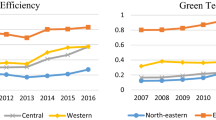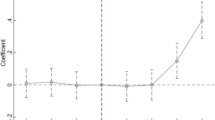Abstract
Does environmental quality affect firms’ activities that might improve that quality? In this paper, we use China's public heating policy as a quasi-experiment to investigate the impact of exogenous pollution differences on green innovation behavior. We use a regression discontinuity model, and carry out a suite of robustness tests. We consistently find that firms located in cities with an exogenous source of heavy pollution tend to adopt green innovation at a lower rate while we find no difference in the rate at which they adopt non-green innovation. We find a strong causal effect: being north of the boundary, where pollution levels are higher, leads firms to adopt less green innovation. Firms located in the heating areas report roughly 1 less green innovation per billion RMB of assets, a substantial difference given the average number of green innovations per billion RMB of assets of northern firms is 0.641.




Similar content being viewed by others
Notes
Website link: https://www.baiten.cn.
Website link: http://us.gtadata.com.
In Appendix B, we describe what data are being used, and how we downloaded the data.
In the appendix, we show a detailed summary statistics.
The 10 industries include: mining, power generation, textile, steel, chemical, petrochemical, cement, metallurgical, pharmaceutical, paper.
The variables used to calculate the propensity score and the Mahalanobis distance are firm’s total asset and the industry they belong to. In Appendix Table 11 we also show the regression result using dataset created using Mahalanobis distance matching.
A comparison between the cost of heating in the south and north: the heating cost in the north is proximately 10 times of the cost in the south.
Source: https://finance.sina.com.cn/china/20140102/162117824915.shtml?from=wap.
Here is the company’s registration page:
https://data.cyzone.cn/content/dbase/company?cat_id=637&content_id=1312510
The user manual only has Chinese version, and can be downloaded here:
The English website of China National Intellectual Property Administration:
References
Almond D, Chen Y, Greenstone M, Li H (2009) Winter heating or clean air? Unintended impacts of China’s Huai river policy. Am Econ Rev 99:184–190
Badami MG (2005) Transport and urban air pollution in India. Environ Manage 36:195–204
Bansal P, Clelland I (2004) Talking trash: legitimacy, impression management, and unsystematic risk in the context of the natural environment. Acad Manag J 47:93–103
Brunnermeier SB, Cohen MA (2003) Determinants of environmental innovation in US manufacturing industries. J Environ Econ Manage. https://doi.org/10.1016/S0095-0696(02)00058-X
Cai W, Li G (2018) The drivers of eco-innovation and its impact on performance: evidence from China. J Clean Prod 176:110–118
Calonico S, Cattaneo MD, Titiunik R (2015) Optimal data-driven regression discontinuity plots. J Am Stat Assoc 110:1753–1769
Chen Y, Ebenstein A, Greenstone M, Li H (2013) Evidence on the impact of sustained exposure to air pollution on life expectancy from China’s Huai River policy. Proc Natl Acad Sci 110:12936–12941
Chen X, Yi N, Zhang L, Li D (2018) Does institutional pressure foster corporate green innovation? Evidence from China ’s top 100 companies. 188:304–311.
Dalton DR, Daily CM, Johnson JL, Ellstrand AE (1999) Number of directors and financial performance: a meta-analysis. Acad Manag J 42:674–686
Eltayeb T, Zailani S (2014) Going green through green supply chain initiatives toward environmental sustainability. Oper Supply Chain Manag an Int J 2:93–110
He W, Shen R (2019) ISO 14001 Certification and corporate technological innovation: evidence from Chinese firms. J Bus Ethics 158:97–117
Hijmans, R. J., William, E., Vennes, C., et al. (2019) Package ‘geosphere’
Horbach J (2008) Determinants of environmental innovation-new evidence from German panel data sources. Res Policy 37:163–173
Imbens GW, Lemieux T (2008) Regression discontinuity designs: a guide to practice. J Econom 142:615–635
Keele LJ, Titiunik R (2015) Geographic boundaries as regression discontinuities. Polit Anal 23:127–155
Lanoie P, Laurent-Lucchetti J, Johnstone N, Ambec S (2011) Environmental policy, innovation and performance: new insights on the Porter hypothesis. J Econ Manag Strateg 20:803–842
Lee DS, Lemieux T (2010) Regression discontinuity designs in economics. J Econ Lit 48:281–355
Li D, Zheng M, Cao C et al (2017) The impact of legitimacy pressure and corporate profitability on green innovation: evidence from China top 100. J Clean Prod 141:41–49. https://doi.org/10.1016/j.jclepro.2016.08.123M4-Citavi
Li D, Huang M, Ren S et al (2018a) Environmental legitimacy, green innovation, and corporate carbon disclosure: evidence from CDP China 100. J Bus Ethics 150:1089–1104. https://doi.org/10.1007/s10551-016-3187-6
Li D, Zhao Y, Zhang L et al (2018b) Impact of quality management on green innovation. J Clean Prod 170:462–470
Li WD (2017). Annual report on social development of Beijing: Social Science Academic Press.
Lu H, Chen H, Long RY (2018) Smog besieging the city: the influence mechanism of smog perception on talents flow tendency under dual channel perspective. Business Management Journal 40:104–124
OECD. (2010). Eco-innovation in industry: Enabling green growth: OECD Publishing.
OECD. (2012). The future of eco-innovation: The role of business models in green transformation.
Pargal S, Wheeler D (1996) Informal regulation of industrial pollution in developing countries: evidence from Indonesia. J Polit Econ 104:1314–1327
Popp D (2019) Environmental policy and innovation: a decade of research
Rohde RA, Muller RA (2015) Air pollution in China: mapping of concentrations and sources. PLoS ONE 10:e0135749. https://doi.org/10.1371/journal.pone.0135749PM-26291610
Sezen B, Cankaya SY (2013) Effects of green manufacturing and eco-innovation on sustainability performance. Procedia-Social Behav Sci 99:154–163
Wan G, Zhang Y (2018) The direct and indirect effects of infrastructure on firm productivity: evidence from Chinese manufacturing. China Econ Rev 49:143–153
Wei C, Huang Y, Guo J (2014). The argue on the public heating between the north and south: a study based on a household survey.
Xiao Q, Ma Z, Li S, Liu Y (2015) The impact of winter heating on air pollution in China. PLoS One 10: e0117311.
Funding
Woodward acknowledges support from Texas AgriLife Research with support from the USDA National Institute of Food and Agriculture, Hatch project 1011850.
Author information
Authors and Affiliations
Corresponding author
Ethics declarations
Conflicts of interest
The authors have no relevant financial or non-financial interests to disclose.
Additional information
Publisher's Note
Springer Nature remains neutral with regard to jurisdictional claims in published maps and institutional affiliations.
Statement of exclusive submission: This paper has not been submitted elsewhere in identical or similar form, nor will it be during the first three months after its submission to the Publisher.
Appendices
Appendix A
Appendix B
Detailed data description on green innovation data
Our green innovation data are from the Baiten company, which is a company that provides patent service, searching, and consulting services.Footnote 8 On their website, https://www.baiten.cn/, one can search for the patent data of China and other countries. This paper uses only Chinese patent data. According to the user manual,Footnote 9 the patent data are from China National Intellectual Property Administration,Footnote 10 thus every patent filed in that bureau will be included as a patent count.
We first obtained the listed firms from China Stock Market & Accounting Research Database (CSMAR); there are 997 firms on the list. We also used the firm performance data from CSMAR. The location data used are the registration addresses from CSMAR. These are firm-level data, not plant-level data. The full list of firms is included in the dataset provided on Github.
For each listed firm, two searches were carried out, first to identify the firm’s patents that can be characterized as green innovations between 2013 and 2017, and then for all patents over this period. To gain access to the data, the Baiten company requires one to register using a Chinese phone number. Therefore, those who do not have a Chinese phone number cannot download the data through the website.
For example, for the Datang International Power Generation Co., Ltd., we carried out the following search from the search window at https://www.baiten.cn/:
cpa:(大唐国际发电股份有限公司) AND (ad:[2013 TO 2017]) AND (碳 or 环境 or 环保 or 节能 or 生态 or 废 or 清理 or 清洁 or 绿色 or 回收 or 能耗 or 循环 or 净化 or 脱硫 or节约资源 or 无污染)
There are different parts of the search code:
-
the name of the company searched: “大唐国际发电股份有限公司”;
-
the time range searched: “2013 TO 2017”; and
-
the types of patents to be reported
Our keywords to identify green innovation patents are primarily based on Li et al. (2018a, b) and Li et al. (2017), patents in the following categories are included in the list of green innovations: carbon (碳), environment (环境), environmental protection (环保), energy-saving (节能), ecology (生态), waste (废), clean (清理, 清洁), green (绿色), recycling (回收), energy consumption (能耗), natural cycling (循环), purification (净化), desulfurization (脱硫), resource-saving (节约资源), pollution-free (无污染).
The number of green innovations for each firm are then found by clicking on “专利趋势分析” (Patent trend analysis), revealing an image like the one below:
The central part of Fig.
5 shows the year and the number of green innovations for each year. These numbers were manually typed into our dataset.
To obtain the complete count of innovations, we use the same process, excluding the types of patents to be reported different searching codes. The search code for all innovations by a firm would be:
cpa:(大唐国际发电股份有限公司) AND (ad:[2013 TO 2017])
These steps are repeated for each company, until we have all the innovation data for all the listed companies.
All data and code in R used are available at https://github.com/faust1987/The-Impact-of-Exogenous-Pollution-on-Green-Innovation. Data are presented in both the original Chinese, and with key words translated into English.
Rights and permissions
About this article
Cite this article
Wang, Y., Woodward, R.T. & Liu, JY. The Impact of Exogenous Pollution on Green Innovation. Environ Resource Econ 81, 1–24 (2022). https://doi.org/10.1007/s10640-021-00614-5
Accepted:
Published:
Issue Date:
DOI: https://doi.org/10.1007/s10640-021-00614-5





